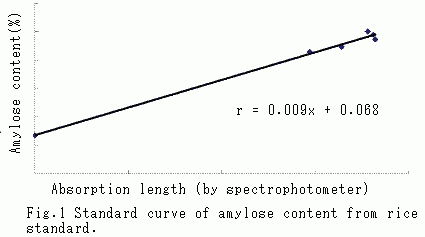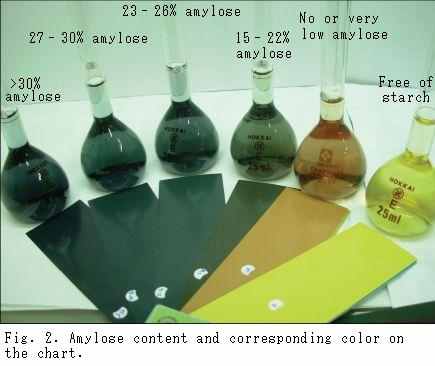[ホーム>発表論文>本文]
吉田総合案内へ戻る.
本頁は PPS 12 に掲載.
A Simple and Low-cost Method to Classify Amylose Content of
Rice Using a Standard Color Chart
Michael Ronoubigouwa Ambouroue Avaro, Ly Tong and Tomohiko Yoshida
Abstract: An alternative method to classify amylose content in rice was developed. In this method, based on amylose-iodine colorimetry, a standard color chart was used instead of a spectrophotometer to successfully classify a wide range of cultivars with known and unknown amylose content. This is a rapid low-cost method that may be useful for prediction of amylose content in rice for breeding purposes.
Key words: Amylose content, Amylose-iodine colorimetry, Color chart.
Various methods have been used to determine amylose content of rice flour. New technologies, including molecular markers (Bergam et al., 2001) are used to obtain highly accurate results. However, many of these methods require equipments such as a spectrophotometer; autoanalyzer (Webb, 1978), amylogram, near infrared instrument (Delwiche et al., 1995) and most recently thermocycler (polymerase chain reaction), which are not always available in developing countries, as their acquirement and maintenance costs are very expensive. Amperometric titration (BeMiller, 1964) is a low-cost alternative, but is time consuming. One of the most frequently used methods to determine amylose content is the amylose-iodine colorimetry., We developed a simple method for measuring amylose content, which was based on Juliano’s method (Juliano, 1971), with the use of a low-cost color chart, instead of a spectrophotometer. We applied this method to classify a wide range of cultivars with known and unknown amylose content.
Materials and Methods
In order to properly determine the apparent amylose percentage, we made a standard curve using 5 standard rice cultivars with known amylose content (Hiyokumochi, Fukei2465, Nipponbare, Hinohikari and Koganebare), which were kindly provided by Fukuoka Agricultural Research Center with amylose data. The method described by Juliano (1971) was used to make an amylose-iodine solution with the rice flour obtained by manually powdering grains in a faience mortar and pestle. The pH of the solution was corrected and stabilized with corresponding amount of acetic acid. The absorbance at a specific wavelength of the solution at different concentrations was checked by a spectrophotometer calibrated with a control solution containing no rice flour. A linear regression was made using different concentrations and wavelength absorptions (Fig. 1).
At the final step, a simple color chart (Nihon Shikiken Kabu Shiki Kaisha, Haishoku Kaado 158a) was used to estimate apparent amylose content of rice. Measurement by spectrophotometer was performed with two replicate samples taken from the same diluted amylose solution for each cultivar.
In this experiment, we used 7 Cambodian rice cultivars (Phka Mlis, Phka Rumchang, Phka Khgnei, Rumpe, Sarika, Santepheap 3, Popoul); 2 Japanese cultivars (Koshihikari and Yukihikari); 2 interspecific progenies lines (O. sativa x O. glaberrima), NERICA1 and NERICA5 kindly provided by Dr. Tobita (JIRCAS); 3 of the F3 progenies (NEKO5-315bH9, NEKO5-322H5, NEKO5-311cH8) derived from the cross between NERICA5 and Koshihikari; and Tchibanga, a local cultivar of Gabon, kindly provided by IRRI (Table 1.).
Results and Discussion
Five classes of color: reddish yellow, grayish olive, dark grayish green, dark grayish greenish blue and dark grayish blue, corresponded to very low, low, intermediate, high and very high subclasses, respectively (Table1, Fig. 1 and Fig. 2). Three colors may be more practical and simple to identify. Therefore, we classified the amylose content into three levels: very low, reddish yellow for waxy cultivar (Toyohatamochi); middle, grayish olive for 15% to 22% amylose content (Phka Mlis, Koshihikari, Phka Rumchang, Yukihikari, Phka Khgnei);and high dark grayish for over 23% (Rumpe, Sarika, Santepheap 3, Tchibanga, NEKO5-315bH9, NEKO5-322H5, NERICA1, Popoul, NEKO5-311cH8).
Amylose is an important trait of rice grain; it may influence rice processing, utilization and consumption, especially eating quality. Because, it is useful for determining whether amylose content is low or high, this new method can be used to estimate amylose content for breeding, or for quick diagnosis of amylose class of unknown cultivars or lines. In the early selection process, the speediness may be an important factor, when deal with hundreds to thousands of samples. The use of a color chart enables rapid prediction of an acceptable quality. We successfully applied this method to classify 9 additional progeny lines derived from the cross between NERICA5 and Koshihikari (data not shown). As it requires only basic laboratory tools such as standard chemical and classic vessels in a laboratory, it is a low-cost alternative to the other methods that need expensive equipment.


Table 1. Classification of amylose content using a color chart.
| ────── | ───────── | ─────────── | ──────── |
| Genotypes | Average | Corresponding colors | Corresponding colors |
| from spectrophotometer | (with subclasses) | (no subclasses) |
| Toyohatamochi | - | Very low | Very low |
| | Reddish yellow | Reddish yellow |
| ────── | ───────── | ─────────── | ──────── |
| Phka Mlis | 15.56±0.15 | Low | Low ~ middle |
| Koshihikari | 16.90±2.62 | (15-22% AC) | (15-22% AC ) |
| Phka Rumchang | 18.03±0.44 | Grayish olive | Grayish olive |
| Yukihikari | 20.92±0.15 |
| Phka Khgnei | 22.16±0.15 |
| |
| ────── | ───────── | ─────────── | ──────── |
| Rumpe | 25.09±0.95 | Intermediate |
| Sarika | 25.40±1.53 | (23-26% AC) |
| Santepheap 3 | 25.56±1.02 | Dark grayish green | High |
| ────── | ───────── | ─────────── | ──────── |
| Tchibanga | 26.75±1.10 | High | Dark grayish |
| NEKO5-315bH9 | 27.62±1.31 | (27-30% AC) |
| NERICA5 | 28.91±0.08 | Dark grayish greenish blue |
| NEKO5-322H5 | 29.89±1.02 |
| ────── | ───────── | ─────────── | ──────── |
| NERICA1 | 30.86±1.53 | Very high | Very high |
| Popoul | 31.18±0.07 | (>30% AC ) | (>30% AC ) |
| NEKO5-311cH8 | 34.63±0.44 | Dark grayish blue | Dark grayish blue |
| ────── | ───────── | ─────────── | ──────── |
AC: amylose content (%).
References
BeMiller, J.N. 1964. In Whistler R. L., Simth R. J., BeMiller J. N. and Wolfrom M. L. eds,
Methods in Carbohydrate Chemistry. Academic Press, New York. 165-168.
Bergman, C. J. et al. 2001. Cereal Chem.78 : 257-260.
Delwiche, S. R. et al. 1995. Cereal Chem. 72 :182-188.
Juliano, B. O. 1971. Cereal Sci.Today 16 : 334?340.
Webb, B.D. 1978. Cereal Sci. Today 30 : 284.
以上

